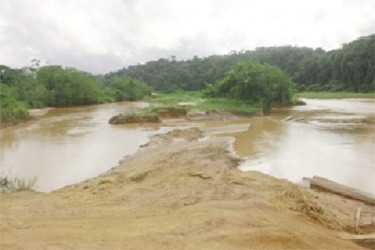The Environmental Protec-tion Agency (EPA) is making arrangements to conduct a detailed biological assessment of the damaged Konawaruk River and the Ministry of Natural Resources and the Envi-ronment has acknowledged the need to increase monitoring of mining operations there.
Stabroek News reported last September that the Konawaruk River in Region Eight is still heavily silted more than a decade after attention was first drawn to the degraded state of the waterway as a result of mining. It had previously been branded a “dead” river – incapable of supporting aquatic life but this has drawn varying views. “It would be difficult to say that without carrying out a proper assessment,” Dr David Singh, the head of Conservation International-Guyana had said. He had pointed out that the period for which the river has remained in a heavily polluted state – 10 to 15 years – is more than the lifespan of aquatic species.
Former head of the GGMC William Woolford, who is now a consultant in the mining industry, however, was adamant that the Region Eight river is not dead. And Major General (rtd) Joseph Singh, who first expressed concern about the state of the river over a decade ago, has said that there is need for a technical evaluation to determine the extent of the damage to the Konawaruk River.

In responding to questions from Stabroek News, the Natural Resources and Environment ministry said that an assessment of the state of the Konawaruk River conducted in September 2013- following the publication of an article in this newspaper- revealed that the turbidity and Total Suspended Solids (TSS) levels have decreased from those recorded in 2002 and 2010 respectively.
“The EPA and GGMC sees the need to and are currently increasing their efforts in monitoring and enforcement in the area, including encouraging improved tailings management, and issuing cease work orders,” the ministry said. “The EPA is also currently examining the potential for silt curtains as an option to help reduce sedimentation and will collaborate with GGMC towards encouraging its use among small-scale mining operations,” it added.
Minister of Natural Resources and the Environment Robert Persaud had previously acknowledged that the Region Eight (Potaro/ Siparuni) river has been degraded by mining activities and said that action can be taken to help the river recover. “With proper management of tailings by miners, constant monitoring and enforcement by GGMC [Guyana Geology and Mines Commission] and EPA [Environmental Protection Agency], the river can recuperate. If required as a last resort, targeted/direct environmental restoration has been done in many other places, including restoration of rivers and biodiversity. If the situation warrants it, we are sure it can be done here as well,” the minister had said.
At the time, mining and environmental protection officials were due to visit the Konawaruk River to check on its state and Persaud had said that an assessment is needed to determine whether the river is supporting aquatic life.
Conducive
The ministry, in its statement, told Stabroek News that the river is supporting aquatic life. “Whilst not conclusive, observations and anecdotal evidence revealed that there is aquatic life in the Konawaruk River. Dissolved oxygen levels were within the range conducive to supporting aquatic life,” the statement said. It added that the EPA is making arrangements to conduct a detailed biological assessment of the Konawaruk River.
The ministry did not address other questions submitted by Stabroek News including in relation to whether any companies or mining operations have been identified as responsible for the siltation of the river, and if any penalties were applied.
Last year, Persaud had told Stabroek News that the GGMC has monitored the situation with particularly increased intensity since 2010 when it conducted a major exercise to reduce the level of turbidity along the Konawaruk River. “The Lower Konawaruk in particular was identified as one of the locations where the turbidity was cited to be above the critical limit of 30 NTUs (turbidity units),” he had revealed. Persaud had said that the goal of that GGMC exercise was to reduce the turbidity in the Konawaruk River to the acceptable limit of 30 to 50 NTUs.
The minister had recounted that the GGMC’s findings revealed that the mining company, North American Resources Limited (NARIL) was the major contributor to the high level of turbidity. A follow-up of the area after the exercise was completed showed that the turbidity levels were reduced, he had said.
Persaud had recounted that in November – December 2010, a study of turbidity and suspended solids in the Konawaruk River Basin in relation to small and medium-scale gold mining was done by the GGMC’s Environmental Division. “General observations from the water quality testing of the Konawaruk River found that higher total suspended solids and turbidity with corresponding high sediment yield was found downstream of mining operations, particularly higher levels below NARIL,” he said.
Consequently, the GGMC required the company to implement abatement measures and the company submitted in March 2011, a plan titled ‘Konawaruk Tailings Abatement Activity and Work Plan.’ In April 2011, a meeting was held in the office of the manager of the GGMC’s Mines Division to discuss the NARIL plan. The review agreed that NARIL would contain and treat its tailings to ensure that discharge was within stipulated limits. Also, NARIL was required to conduct reclamation of existing rivers banks.
“The reports have shown that NARIL operations in the Konawaruk River were the major contributor to the high levels of turbidity in the river. However tailings discharge from other mining operations upstream and downstream of the NARIL operations contributed to the high levels in the river,” the minister had recounted. The status of the plan is not clear.





